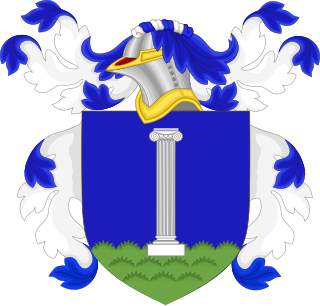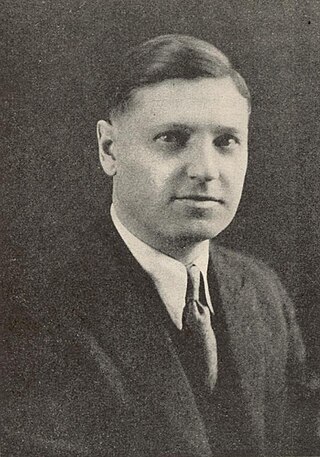
Nylon is a family of synthetic polymers with amide backbones, usually linking aliphatic or semi-aromatic groups.

Pierre Samuel du Pont de Nemours was a French-American writer, economist, publisher and government official. During the French Revolution, he, his two sons and their families migrated to the United States.

Greenville is a bedroom community in New Castle County, Delaware, United States, and a suburb of Wilmington. The population was 2,326 at the 2010 census. For statistical purposes, the United States Census Bureau has defined Greenville as a census-designated place (CDP). The community is also home to the private residence of Joe Biden, the 46th president of the United States, and many Du Pont family descendants.

Éleuthère Irénée du Pont de Nemours was a French-American chemist and industrialist who founded the gunpowder manufacturer E. I. du Pont de Nemours and Company. His descendants, the du Pont family, have been one of the richest and most prominent American families since the 19th century, with generations of influential businessmen, politicians and philanthropists. In 1807, du Pont was elected a member of the American Philosophical Society in his adopted hometown of Philadelphia.

The Hagley Museum and Library is a nonprofit educational institution in unincorporated New Castle County, Delaware, near Wilmington. Covering more than 235 acres (95 ha) along the banks of the Brandywine Creek, the museum and grounds include the first du Pont family home and garden in the United States, the powder yards, and a 19th-century machine shop. On the hillside below the mansion lies a Renaissance Revival garden, with terraces and statuary, created in the 1920s by Louise Evelina du Pont Crowninshield (1877–1958).
Synthetic fibers or synthetic fibres are fibers made by humans through chemical synthesis, as opposed to natural fibers that are directly derived from living organisms, such as plants or fur from animals. They are the result of extensive research by scientists to replicate naturally occurring animal and plant fibers. In general, synthetic fibers are created by extruding fiber-forming materials through spinnerets, forming a fiber. These are called synthetic or artificial fibers. The word polymer comes from a Greek prefix "poly" which means "many" and suffix "mer" which means "single units"..

Stephanie Louise Kwolek was a Polish-American chemist best known for inventing Kevlar. Her career at the DuPont company spanned more than 40 years.

Michael Brown was an American composer, lyricist, writer, director, producer, and performer. He was born in Mexia, Texas. His musical career began in New York cabaret, performing first at Le Ruban Bleu. In the 1960s, he was a producer of industrial musicals for major American corporations such as J.C. Penney and DuPont. For the DuPont pavilion at the 1964 New York World's Fair, Brown wrote and produced a musical revue, The Wonderful World of Chemistry staged 48 times a day by two simultaneous casts in adjacent theaters. For years, he maintained a reunion directory of the cast and crew, which included Robert Downey, Sr. as a stage manager. 2005 mailing: “After all, it was a remarkable time in all of our lives. We can be fairly certain nothing like it will be seen again. Love all round, Mike.” Several of his songs have entered the American repertoire, including "Lizzie Borden" and "The John Birch Society," which were popularized by the Chad Mitchell Trio. Children know him best as the author of three Christmas books about Santa's helper, Santa Mouse.

The du Pont family or Du Pont family is a prominent American family descended from Pierre Samuel du Pont de Nemours (1739–1817), a French minor aristocrat. It has been one of the richest families in the United States since the mid-19th century, when it founded its fortune in the gunpowder business. In the late 19th and early 20th centuries, it expanded its wealth through the chemical industry and the automotive industry, with substantial interests in the DuPont company, General Motors, and various other corporations.

Alfred Victor Philadelphe du Pont de Nemours was a French American chemist and industrialist, who was the eldest son and successor of Éleuthère Irénée du Pont, the founder of the E.I. du Pont de Nemours and Company. His son, Alfred Victor du Pont, was one of founding fathers of the alpha (first) chapter of Phi Kappa Sigma fraternity on October 19, 1850, affiliated with University of Pennsylvania, which is a charter member of the North American Interfraternity Conference.

Francis Gurney du Pont was an American businessman and chemist who was a vice president of E. I. du Pont de Nemours Company and invented smokeless gunpowder with the assistance of cousin Pierre S. du Pont. A member of the du Pont family, Francis had ten children, including E. Paul du Pont, founder of Du Pont Motors.

Lammot du Pont I was an American chemist and a key member of the du Pont family and its company in the mid-19th century.

The DuPont Experimental Station is the largest research and development facility of DuPont, located on the banks of the Brandywine Creek in Wilmington, Delaware

Cavalcade of America is an anthology drama series that was sponsored by the DuPont Company, although it occasionally presented musicals, such as an adaptation of Show Boat, and condensed biographies of popular composers. It was initially broadcast on radio from 1935 to 1953, and on television from 1952 to 1957. Originally on CBS, the series pioneered the use of anthology drama for company audio advertising.

From 1802 to 1921, Eleutherian Mills was a gunpowder mill site used for the manufacture of explosives founded by Eleuthère Irénée du Pont, which grew into the DuPont company. The name also refers to the house on the hill above the mills, which was the first du Pont family home in America. In 1957 the site became an outdoor museum when the Hagley Museum and Library was founded. The site was declared a National Historic Landmark in 1966.

Elmer Otto Kraemer was an American chemist whose studies and published results materially aided in the transformation of colloid chemistry from a qualitative to a quantitative science. For eleven years, from 1927 to 1938, he was the leader of research chemists studying fundamental and industrial colloid chemistry problems and a peer of Wallace Hume Carothers at the Experimental Station of the E. I. du Pont de Nemours Company where both men contributed to the invention of nylon that was publicly announced on October 27, 1938. The 1953 Nobel Laureate in chemistry, Hermann Staudinger, had a high regard for the American pioneers in polymer chemistry, particularly Kraemer and Carothers
DuPont de Nemours, Inc., commonly shortened to DuPont, is an American multinational chemical company first formed in 1802 by French-American chemist and industrialist Éleuthère Irénée du Pont de Nemours. The company played a major role in the development of the U.S. state of Delaware and first arose as a major supplier of gunpowder. DuPont developed many polymers such as Vespel, neoprene, nylon, Corian, Teflon, Mylar, Kapton, Kevlar, Zemdrain, M5 fiber, Nomex, Tyvek, Sorona, Corfam and Lycra in the 20th century, and its scientists developed many chemicals, most notably Freon (chlorofluorocarbons), for the refrigerant industry. It also developed synthetic pigments and paints including ChromaFlair.
Atlas Powder Company was an American explosives and chemicals company. It was one of the two companies that emerged out of a court-ordered breakup of the explosives monopoly of Du Pont Powder Company, the explosives and gunpowder company founded by French-American chemist and industrialist Éleuthère Irénée du Pont de Nemours.

Jacques Antoine Bidermann, also known as James Antoine Bidermann, was an American businessman of French and Swiss origins who became the business partner and son-in-law of Éleuthère Irénée du Pont. He married into the Du Pont family and founded the estate that later became the Winterthur Museum, Garden and Library.
















